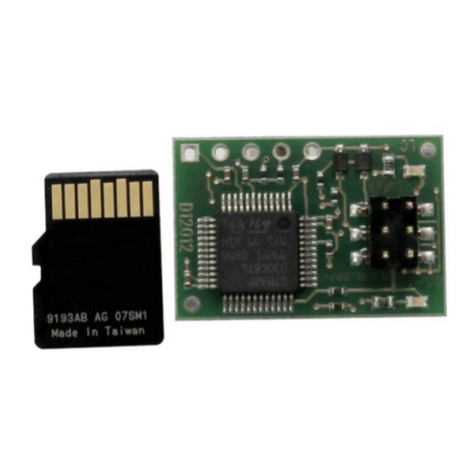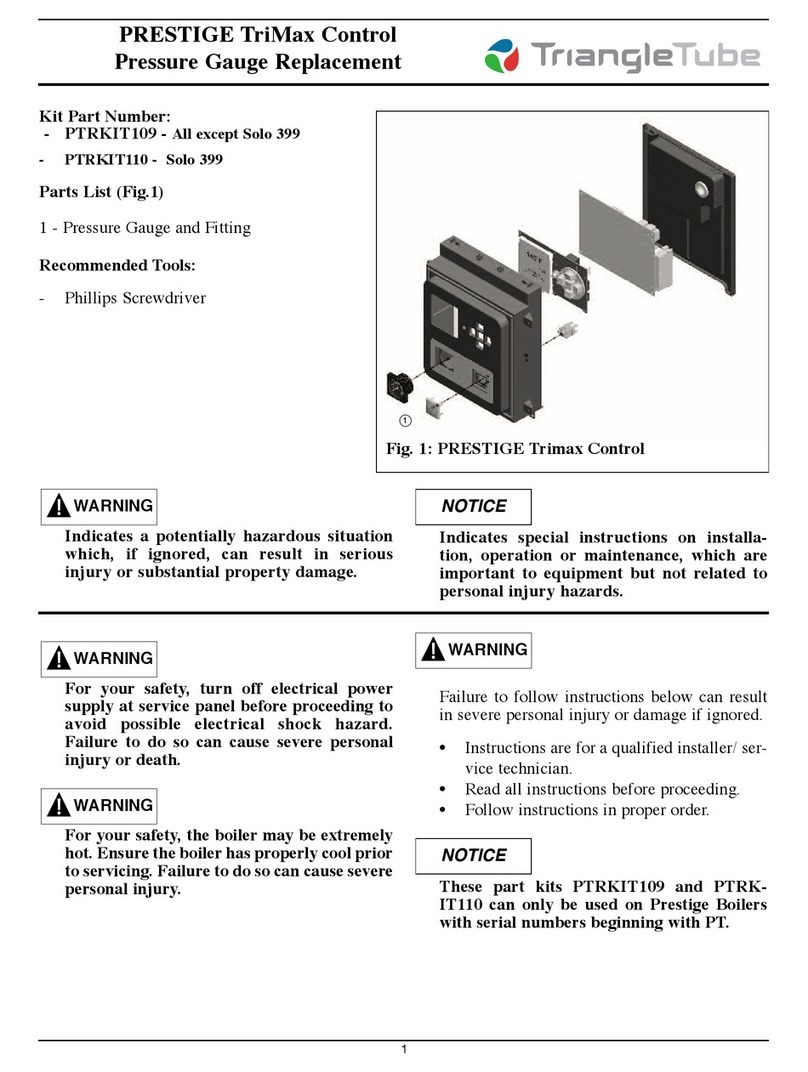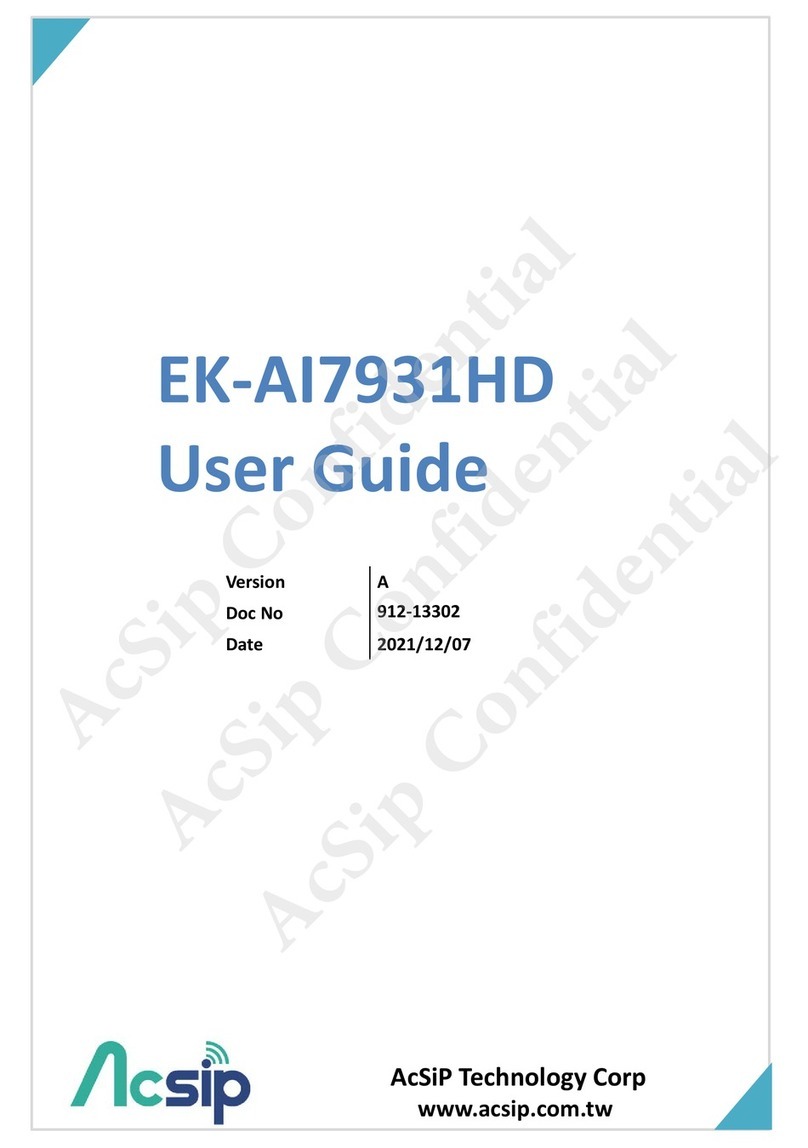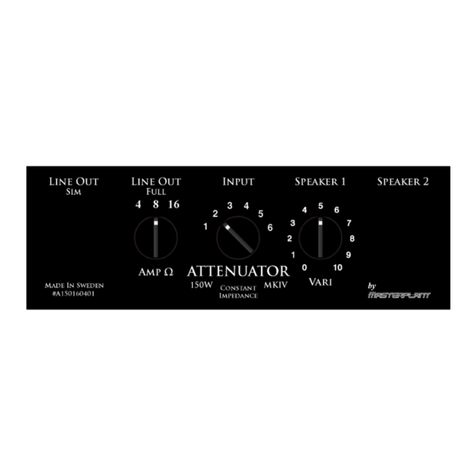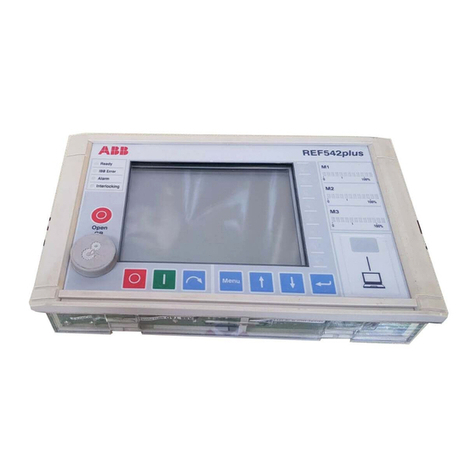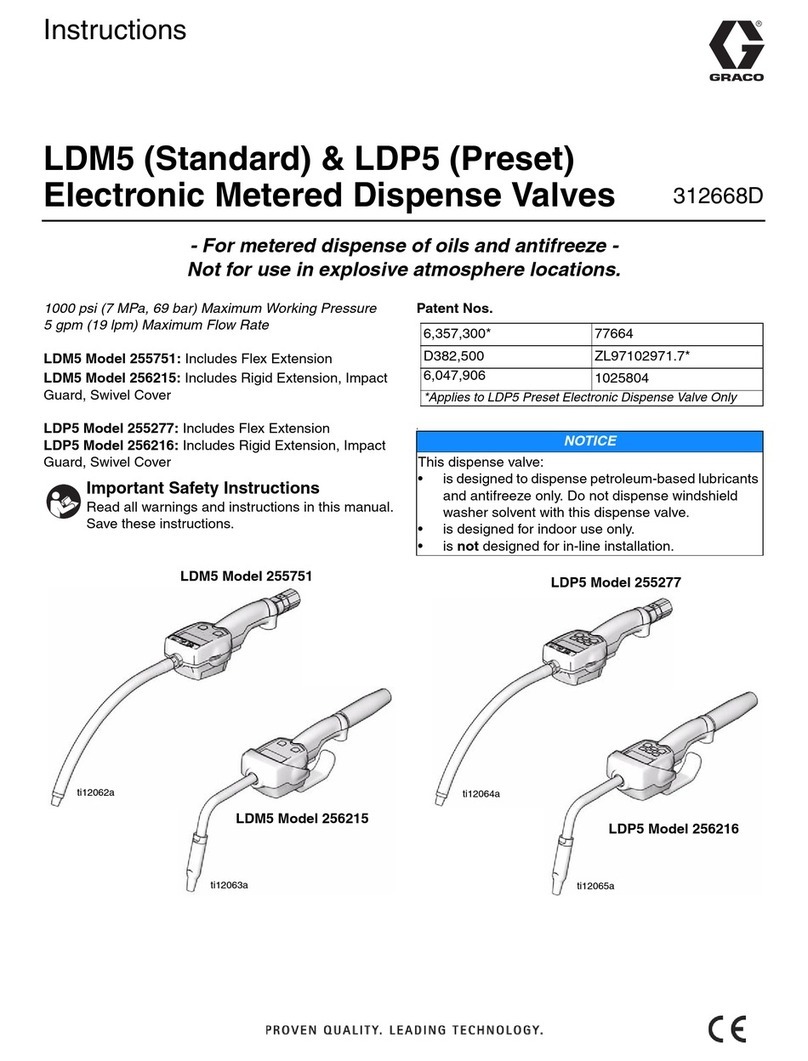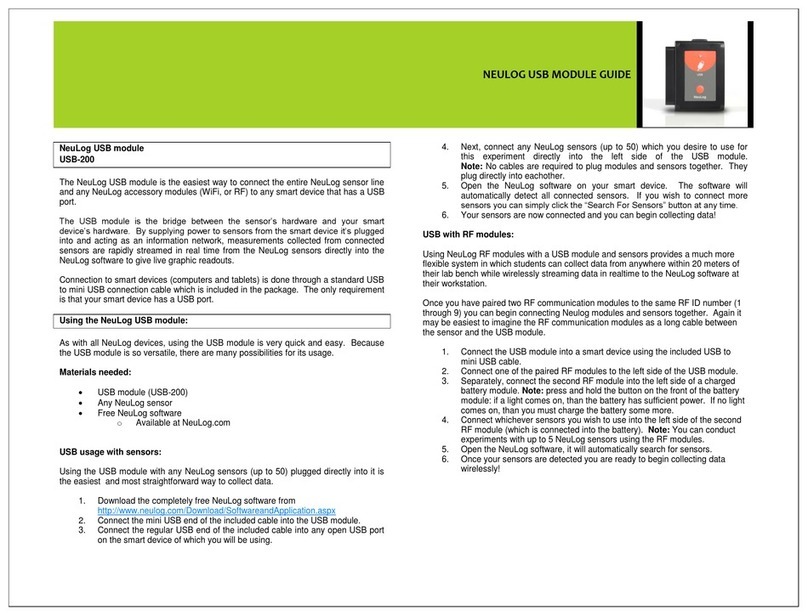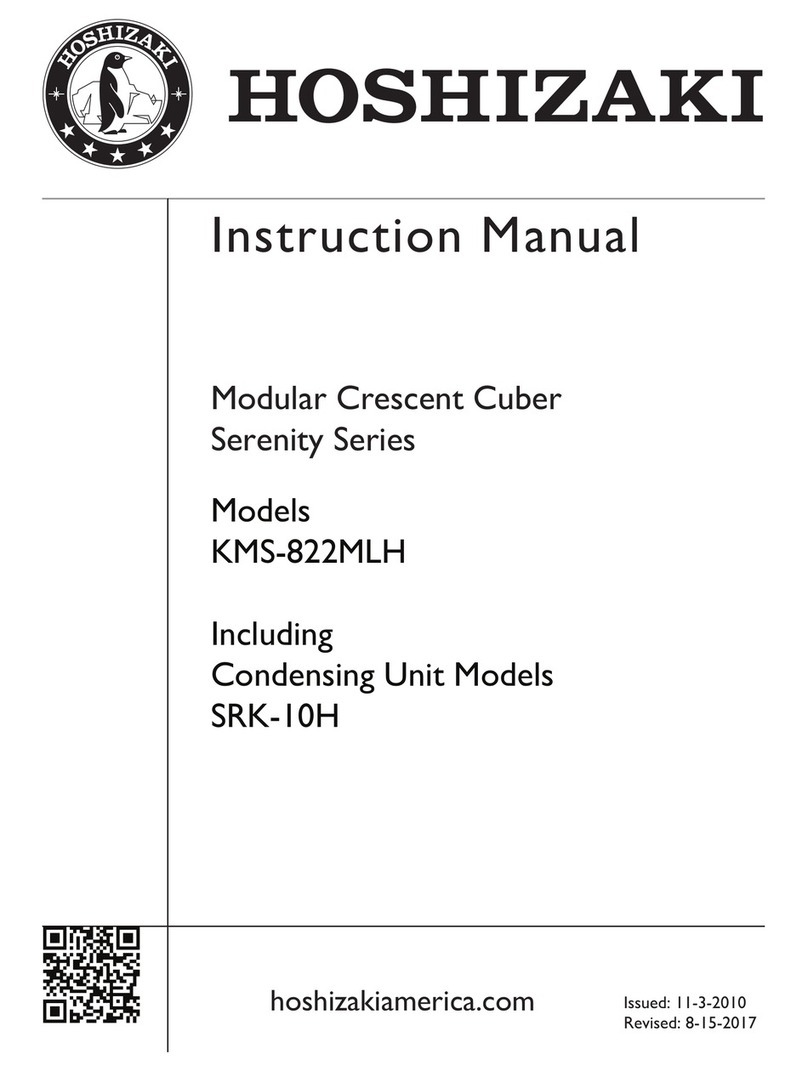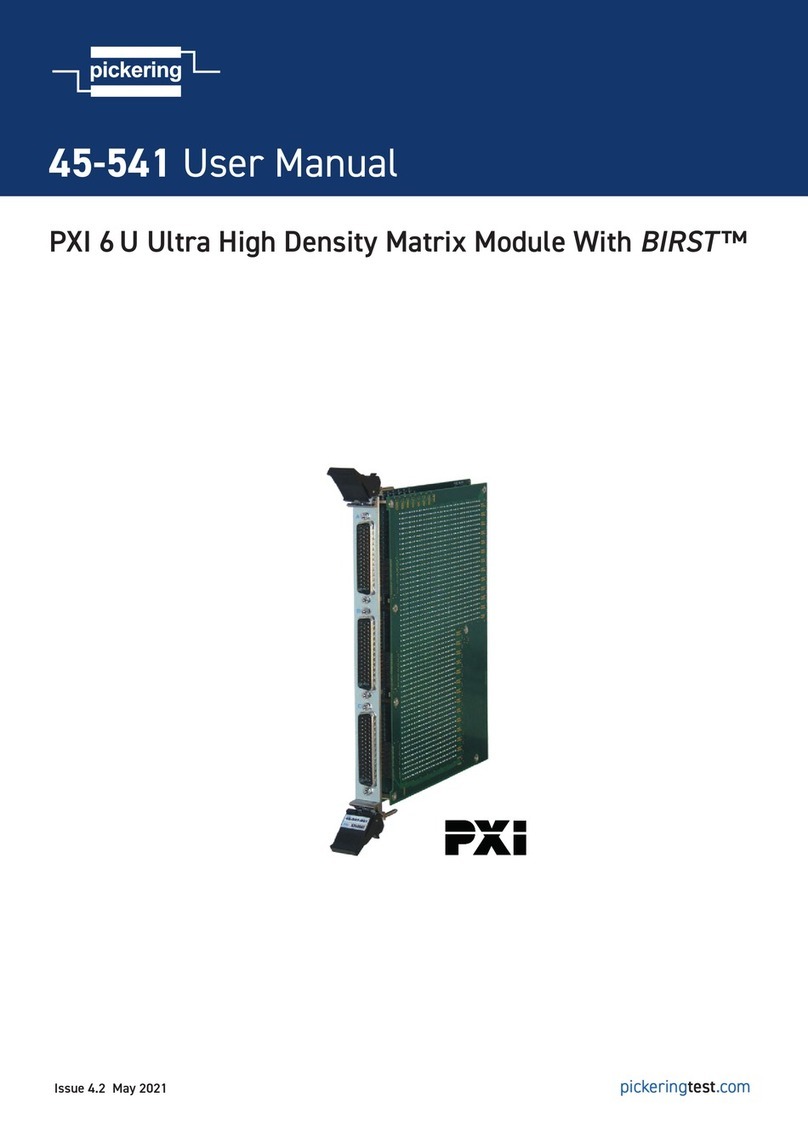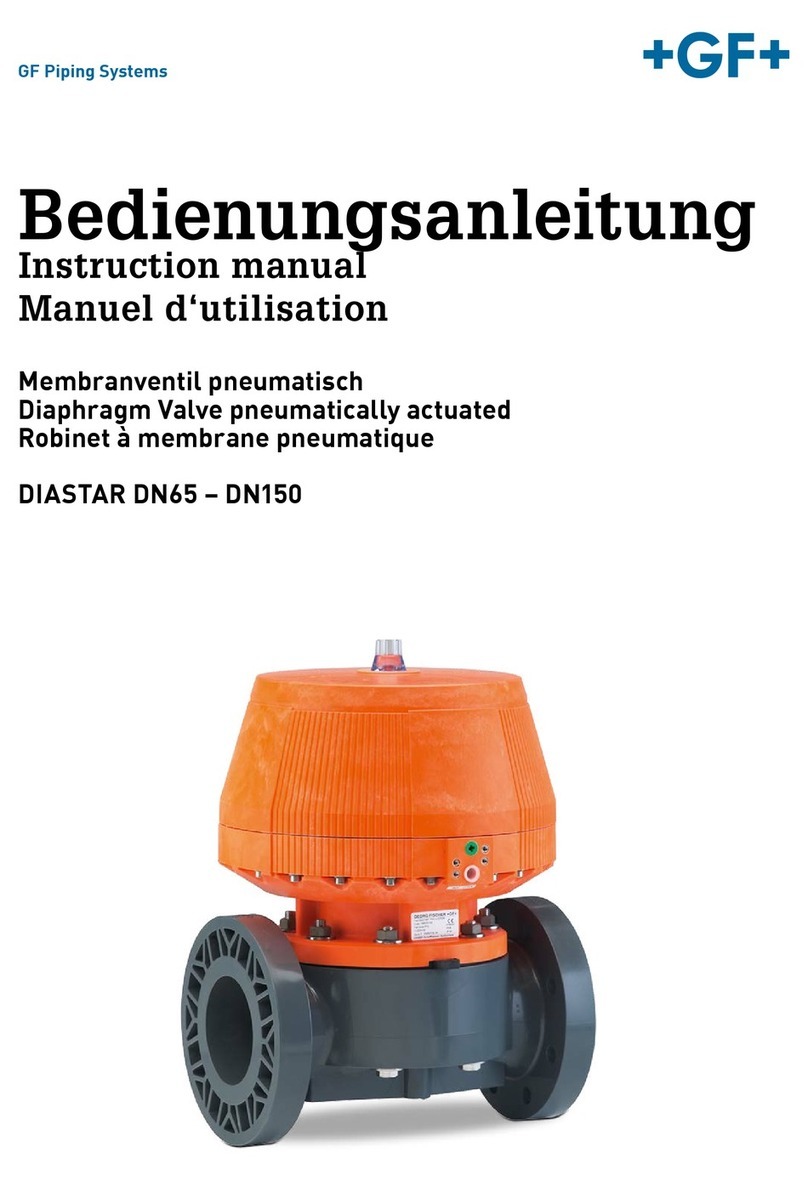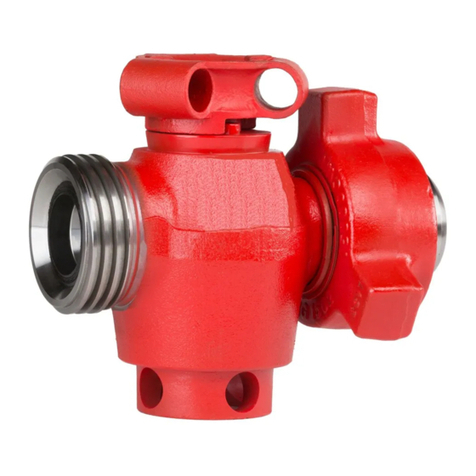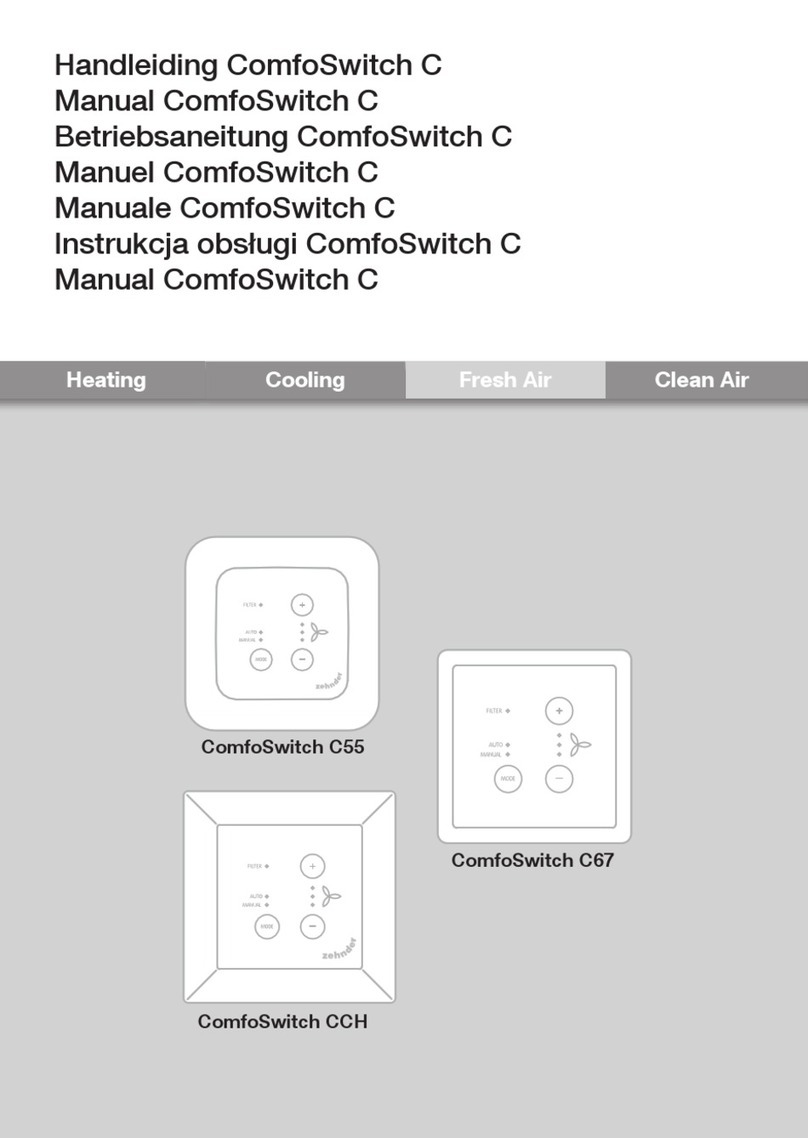StepperOnline DM542T User manual

User Manual
DM542T(V4.0)
2-Phase Digital Stepper Drive
Revision 4.0
Record of Revisions
Revision
Date
Description of Release
1.0
Dec, 2016
Initial Release
4.0
Oct., 2020
Add 5V/24V logical voltage selector, alarm outputs

Table of Contents
1. Features.............................................................................................................................................................................1
2. Specifications.................................................................................................................................................................... 1
2.1 Electrical Specifications.......................................................................................................................................... 1
2.2 Environment............................................................................................................................................................1
2.3 Mechanical Specifications...................................................................................................................................... 2
2.4 Elimination of Heat................................................................................................................................................. 2
3. Connection Pin Assignments and LED Indication.............................................................................................................2
3.1 P1 - Control Connector........................................................................................................................................... 3
3.2 P2 - Fault and Brake Output Connector................................................................................................................. 3
3.3 P3 - Motor and Power Supply Connector...............................................................................................................3
3.5 LED Light Indication................................................................................................................................................ 3
4. Control Signal and Output Signal......................................................................................................................................4
4.1 Control Signal Connection...................................................................................................................................... 4
4.2 Fault Output Connection........................................................................................................................................ 4
5. Motor Connection.............................................................................................................................................................4
6. Power Supply Selection.................................................................................................................................................... 5
6.1Power Supply Sharing.............................................................................................................................................. 5
6.2 Selecting Supply Voltage.........................................................................................................................................5
7. DIP Switch Configurations.................................................................................................................................................5
7.1 Microstep Resolution Configurations.....................................................................................................................5
7.2 Output Current Configurations...............................................................................................................................6
7.2.1 Dynamic Current Configurations................................................................................................................. 6
7.2.2 Idle Current Configuration...........................................................................................................................7
7.3 Automatic Motor Matching & Self Configuration.................................................................................................. 7
8. Wiring Notes..................................................................................................................................................................... 7
9. Typical Connection............................................................................................................................................................7
10. Sequence Chart of Control Signals................................................................................................................................. 8
11. Protection Functions.......................................................................................................................................................8
12. Troubleshooting.............................................................................................................................................................. 9

DM542T(V4.0) Digital Stepper Drive User Manual
1
1. Features
Step & direction (PUL/DIR) control
Input voltage 20-50VDC (recommended 24-48VDC)
200 KHz max pulse input frequency
16 microstep resolutions of 200-25,600 via DIP switches
8 output current settings of 1.0-4.5A via DIP Switches
Idle current reduction to 50% or 90% selection via SW4
Auto-tuning to match wide-range NEMA 11, 17, 23 and 24 stepper motors
Anti-Resonance for optimal torque, extra smooth motion, low motor heating and noise
Soft-start with no “jump” when powered on
Optically isolated inputs with 5V or 24V
Fault output
Over-voltage and over-current protections
2. Specifications
2.1 Electrical Specifications
Parameters
DM542T(V4.0)
Min
Typical
Max
Unit
Output Current
1.0 (0.7 RMS)
-
4.5 (3.2 RMS)
A
Supply Voltage
18
24 - 48
50
VDC
Logic signal current
7
10
16
mA
Pulse input frequency
0
-
200
kHz
Minimal Pulse Width
2.5
-
-
μS
Minimal Direction Setup
5.0
-
-
μS
Isolation resistance
500
MΩ
2.2 Environment
Cooling
Natural Cooling or Forced cooling
Operating Environment
Environment
Avoid dust, oil fog and corrosive gases
Humidity
40%RH-90%RH
Operating Temperature
0°C -40°C (32°F - 109°F)
Vibration
10-50Hz / 0.15mm
Storage Temperature
-20°C -65°C (-4°F - 149°F)
Weight
Approx. 230g (0.51 lbs)

DM542T(V4.0) Digital Stepper Drive User Manual
2
2.3 Mechanical Specifications
(unit: mm [1inch=25.4mm])
Figure 1 Mechanical specifications
Side mounting recommended for better heat dissipation
2.4 Elimination of Heat
DM542T(V4.0) reliable working temperature should be < 40℃(109°F)
It is recommended to use automatic idle-current mode to reduce motor heating. That means set the SW4 pin of
DIP switch at “OFF” position.
It is recommended to mount the drive vertically to maximize heat sink area. Use forced cooling method to cool if
necessary.
3. Connection Pin Assignments and LED Indication
Figure 2 Connectors, DIP switches, and LED locations
The DM542T(V4.0) has three connector blocks P1&P2&P3 (see above picture). P1 is for control signals connections,
and P2 is for output signals connections, P3 is for power and motor connections. The following tables are brief
descriptions of the three connectors. More detailed descriptions of the pins and related issues are as below.

DM542T(V4.0) Digital Stepper Drive User Manual
3
3.1 P1 - Control Connector
PIN
Details
PUL+
Pulse and Direction Connection:
(1) Optically isolated, high level 4.5-5V or 24V, low voltage 0-0.5V
(2) Maximum 200 KHz input frequency
(3) The width of PUL signal is at least 2.5μs, duty cycle is recommended 50%
(4) DIR signal requires advance PUL signal minimum 5 μs in single pulse mode
(5) The factory setting of control signal voltage is 24V, must need to set S2 (figure 2) if it is 5V
PUL-
DIR+
DIR-
ENA+
Enable Connection: (default no connection)
(1) Optically isolated, differential.
(2) Disable the drive by 4.5- 24V input connection; enable the drive by 0-0.5V connection
(3) ENA signal requires advance DIR signal minimum 5μs in single pulse mode
(4) Enable time to be at least 200ms
ENA-
Notes:
(1) Shield cables are required for P1;
(2) Don’t tie P1/P2 cables and P3 cables together.
3.2 P2 - Fault Output Connector
Pin
Details
ALM+
(1) Maximum 30V/100mA output
(2) Sinking or sourcing
(3) The resistance between ALM+ and ALM- is low impedance as default, and will change to
high when the drive goes into error protection.
(4) Fault connection refer to chapter 4.2
ALM-
3.3 P3 - Motor and Power Supply Connector
Pin Function
Details
GND
Power supply ground connection.
+Vdc
Power supply positive connection. Suggest 24-48VDC power supply voltage
A+, A-
Motor Phase A connections. Connect motor A+ wire to A+ Pin; motor A- wire to A-
B+, B-
Motor Phase B connections. Connect motor B+ wire to B+ Pin; motor B- wire to B-
!
Warning
Warning: Don’t plug or unplug the P1&P2&P3 terminal block to avoid drive damage or injury when
DM542T(V4.0) is powered on.
3.4 LED Light Indication
There are two LED lights for DM542T(V4.0). The GREEN one is the power indicator which will be always on generally.
The RED one is a protection indicator which will flash 1-2 times in a 3-second period, when protection enabled for a
DM542T(V4.0). Different number of flashes indicates different protection type (read section 11 for detail).

DM542T(V4.0) Digital Stepper Drive User Manual
4
4. Control Signal and Output Signal
4.1 Control Signal Connection
The DM542T(V4.0) can accept can accept differential or single-ended control signals (pulse, direction, and enable) in
open-collector or PNP connection through the P1 connector (figure 2). It is recommend to add an EMI line filter
between the power supply and the drive to increase noise immunity for the drive in interference environments.
Figure 4: Connections to open-collector signal Figure 5: Connections to PNP signal
(common-anode) (common-cathode)
Notes:
(1) ENA signal is no-connected as default;
(2) Control signal amplitude is 24 V as default. If it is 12 V, please set the S2 (Figure 2) selector switch to 5 V first, then
connect 1KΩ resistor; If it is 5V, please set the S2 to 5V.
4.2 Fault Output Connection
When over voltage or over current protection happens, DM542T(V4.0) red status LED light will blink and the
impedance state between ALM+ and ALM- will change (from low to high or high to low depending on configuration)
and can thus be detected. Fault output connection is optional, and it can be connected either in sinking or sourcing.
Figure 6 Sinking output Figure 7 Sourcing output
5. Motor Connection
The DM542T(V4.0) can drive 2-phase and 4-pahse bipolar hybrid stepper motors.
The 4 lead motors are the least flexible and easy to connect. The output current from drive that is multiply the
specified phase current by 1.4 to determine the peak output current.
Figure 9: 4-lead Motor Connections
Drive
Controller
VCC
PUL-
PUL+
ENA-
PUL
DIR
ENABLE
DIR-
DIR+
ENA+
Drive
Controller
VCC PUL-
PUL+
ENA-
PUL
DIR
ENABLE
DIR-
DIR+
ENA+

DM542T(V4.0) Digital Stepper Drive User Manual
5
6. Power Supply Selection
The DM542T(V4.0) can power medium and large size stepping motors (frame size from NEMA 11 to 24). To get good
driving performances, it is important to select supply voltage and output current properly. Generally speaking, supply
voltage determines the high speed performance of the motor, while output current determines the output torque of
the driven motor (particularly at lower speed). Higher supply voltage will allow higher motor speed to be achieved, at
the price of more noise and heating. If the motion speed requirement is low, it’s better to use lower supply voltage to
decrease noise, heating and improve reliability.
6.1Power Supply Sharing
Multiple DM542T(V4.0) drives can share one power supply to reduce cost, if that power supply has enough power
capacity. To avoid cross interference, connect each stepper drive directly to the shared power supply separately. To
avoid cross interference, DO NOT daisy-chain connect the power supply input pins of the Drivers. Instead connect
them to power supply separately.
6.2 Selecting Supply Voltage
The DM542T(V4.0) is designed to operate within 18 - 50VDC voltage input. When selecting a power supply, besides
voltage from the power supply power line voltage fluctuation and back EMF voltage generated during motor
deceleration needs also to be taken into account. Please make sure leaving enough room for power line voltage
fluctuation and back-EMF voltage charge back.
Higher supply voltage can increase motor torque at higher speeds, thus helpful for avoiding losing steps. However,
higher voltage may cause bigger motor vibration at lower speed, and it may also cause over-voltage protection or
even drive damage. Therefore, it is suggested to choose only sufficiently high supply voltage for intended applications.
7. DIP Switch Configurations
The DM542T(V4.0) has one 8-bit DIP switch and one 1-bit selector. The first 8-bit is used to configure settings of micro
step resolution, output current, motor standstill current, pulse type and smoothing time as shown below.
SW1
SW2
SW3
SW4
SW5
SW6
SW7
SW8
The second 1-bit selector is located on the top (S2 in figure 2), used to configure the voltage of control signals. For the
safety of optically coupled, the factory setting is 24V, which no need to connect 2K resistors like the old drives, making
it easier to use. When the voltage of the control signal is 5V, the S2 must be set to 5V, otherwise, the motor won't
work.
7.1 Microstep Resolution Configurations
Idle Current
Output Current
Microstep

DM542T(V4.0) Digital Stepper Drive User Manual
6
Microstep resolution is set by SW5, 6, 7, 8 of the DIP switches as shown in the following table.
Microstep
Steps/rev.(for 1.8°motor)
SW5
SW6
SW7
SW8
1
200
ON
ON
ON
ON
2
400
OFF
ON
ON
ON
4
800
ON
OFF
ON
ON
8
1600
OFF
OFF
ON
ON
16
3200
ON
ON
OFF
ON
32
6400
OFF
ON
OFF
ON
64
12800
ON
OFF
OFF
ON
128
25600
OFF
OFF
OFF
ON
5
1000
ON
ON
ON
OFF
10
2000
OFF
ON
ON
OFF
20
4000
ON
OFF
ON
OFF
25
5000
OFF
OFF
ON
OFF
40
8000
ON
ON
OFF
OFF
50
10000
OFF
ON
OFF
OFF
100
20000
ON
OFF
OFF
OFF
125
25000
OFF
OFF
OFF
OFF
7.2 Output Current Configurations
For a given motor, higher drive current will make the motor to output more torque, but at the same time causes more
heating in the motor and drive. Therefore, output current is generally set to be such that the motor will not overheat
for long time operation. Since parallel and serial connections of motor coils will significantly change resulting
inductance and resistance, it is therefore important to set drive output current depending on motor phase current,
motor leads and connection methods. Phase current rating supplied by motor manufacturer is important in selecting
drive current, however the selection also depends on leads and connections.
The first three bits (SW1, 2, 3) of the DIP switch are used to set the dynamic current. Select a setting closest to your
motor’s required current.
7.2.1 Dynamic Current Configurations
Peak Current
RMS Current
SW1
SW2
SW3
1.00A
0.71A
ON
ON
ON
1.46A
1.04A
OFF
ON
ON
1.91A
1.36A
ON
OFF
ON
2.37A
1.69A
OFF
OFF
ON
2.84A
2.03A
ON
ON
OFF
3.31A
2.36A
OFF
ON
OFF
3.76A
2.69A
ON
OFF
OFF
4.50A
3.20A
OFF
OFF
OFF

DM542T(V4.0) Digital Stepper Drive User Manual
7
7.2.2 Idle Current Configuration
SW4 is used to set motor idle current percentage. At OFF position it means the standstill current is set to be 50% of
the selected output current. At ON position it means standstill current is set to be 90%.
The current automatically reduced to 50% of the selected dynamic current 0.4 second after the last pulse.
7.3 Automatic Motor Matching & Self Configuration
When powered on a DM542T(V4.0) will automatically configure itself with the best settings to match the driven
stepper motor for optimal performance. No action is needed.
8. Wiring Notes
In order to improve anti-interference performance of the drive, it is recommended to use twisted pair shield
cable.
To prevent noise incurred in PUL/DIR signal, pulse/direction signal wires and motor wires should not be tied up
together. It is better to separate them by at least 10 cm, otherwise the disturbing signals generated by motor will
easily disturb pulse direction signals, causing motor position error, system instability and other failures.
If only one power supply serves multiple DM542T(V4.0) drives, separately connecting the drives to the power
supply is recommended instead of daisy-chaining.
It is prohibited to pull and plug connector P2 while the drive is powered ON, because there is high current
flowing through motor coils (even when motor is at standstill). Pulling or plugging connector P2 with power on
will cause extremely high back-EMF voltage surge, which may damage the drive.
9. Typical Connection
A complete stepping system should include stepping motor, stepping drive, power supply and controller (pulse
generator). A typical connection is shown as below.
Figure 14: Typical connection

DM542T(V4.0) Digital Stepper Drive User Manual
8
10. Sequence Chart of Control Signals
In order to avoid some fault operations and deviations, PUL, DIR and ENA should abide by some rules, shown as
following diagram:
Figure 15: Sequence chart of control signals
Remark:
a) t1: ENA must be ahead of DIR by at least 200ms. Usually, ENA+ and ENA- are NC (not connected). See
“Connector P1 Configurations” for more information.
b) t2: DIR must be ahead of PUL effective edge by 5sto ensure correct direction;
c) t3: Pulse width not less than 2.5s;
d) t4: Low level width not less than 2.5s;
e) Duty cycle of Pulse signal is recommend 50%.
11. Protection Functions
To improve reliability, the drive incorporates some built-in protections features.
Priority
Time(s) of
Blink
Sequence wave of red LED
Description
1st
1
Over-current protection activated when peak
current exceeds the limit.
2nd
2
Over-voltage protection activated when drive
working voltage is greater than 60VDC
3nd
3
Reserved.
When above protections are active, the motor shaft will be free or the red LED blinks. Reset the drive by repowering it
to make it function properly after removing above problems.

DM542T(V4.0) Digital Stepper Drive User Manual
9
12. Troubleshooting
In the event that your drive doesn’t operate properly, the first step is to identify whether the problem is electrical or
mechanical in nature. The next step is to isolate the system component that is causing the problem. As part of this
process you may have to disconnect the individual components that make up your system and verify that they
operate independently. It is important to document each step in the troubleshooting process. You may need this
documentation to refer back to at a later date, and these details will greatly assist our Technical Support staff in
determining the problem should you need assistance.
Many of the problems that affect motion control systems can be traced to electrical noise, controller software errors,
or mistake in wiring.
Problem Symptoms and Possible Causes
Symptoms
Possible Problems
Motor is not rotating
No power
Microstep resolution setting is wrong
DIP switch current setting is wrong
Fault condition exists
The drive is disabled
Motor rotates in the wrong direction
Motor phases may be connected in reverse
The drive in fault
DIP switch current setting is wrong
Something wrong with motor coil
Erratic motor motion
Control signal is too weak
Control signal is interfered
Wrong motor connection
Something wrong with motor coil
Current setting is too small, losing steps
Motor stalls during acceleration
Current setting is too small
Motor is undersized for the application
Acceleration is set too high
Power supply voltage too low
Excessive motor and drive heating
Inadequate heat sinking / cooling
Automatic current reduction function not being utilized
Current is set too high
Other manuals for DM542T
1
Table of contents
Other StepperOnline Control Unit manuals
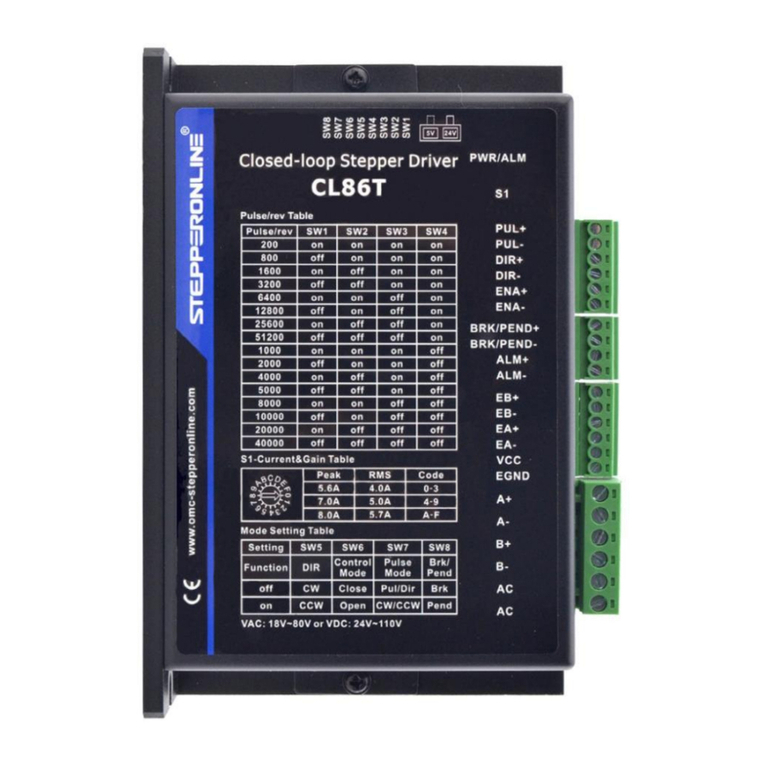
StepperOnline
StepperOnline CL86T User manual
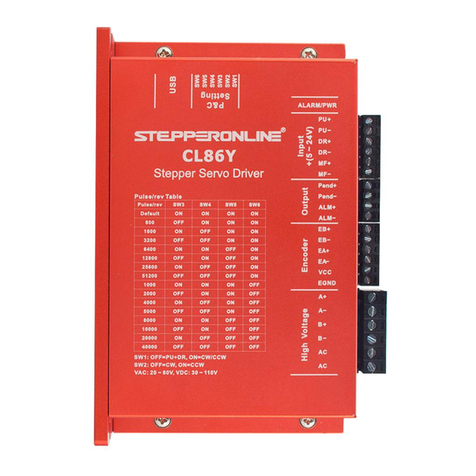
StepperOnline
StepperOnline Y Series Instruction Manual

StepperOnline
StepperOnline MA860H User manual
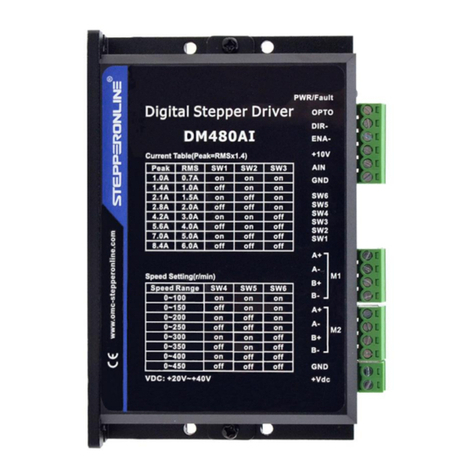
StepperOnline
StepperOnline DM480AI User manual

StepperOnline
StepperOnline CL57T User manual

StepperOnline
StepperOnline CL86T User manual
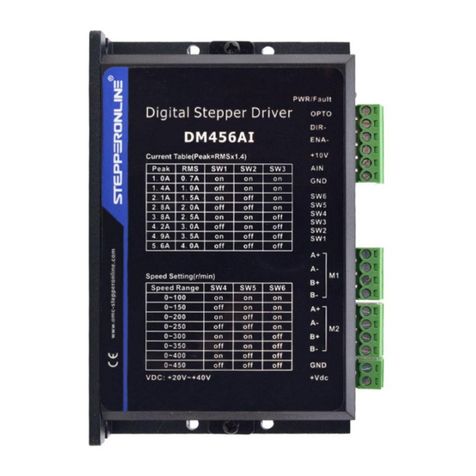
StepperOnline
StepperOnline DM456AI User manual
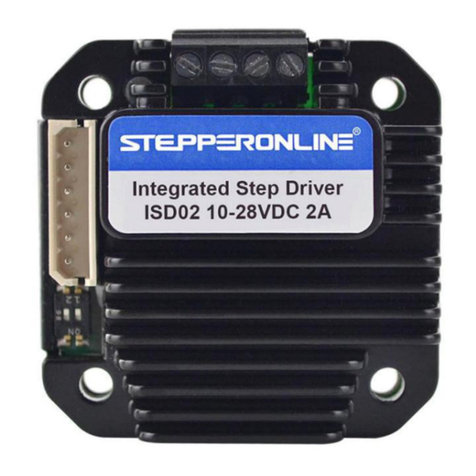
StepperOnline
StepperOnline ISD02 User manual
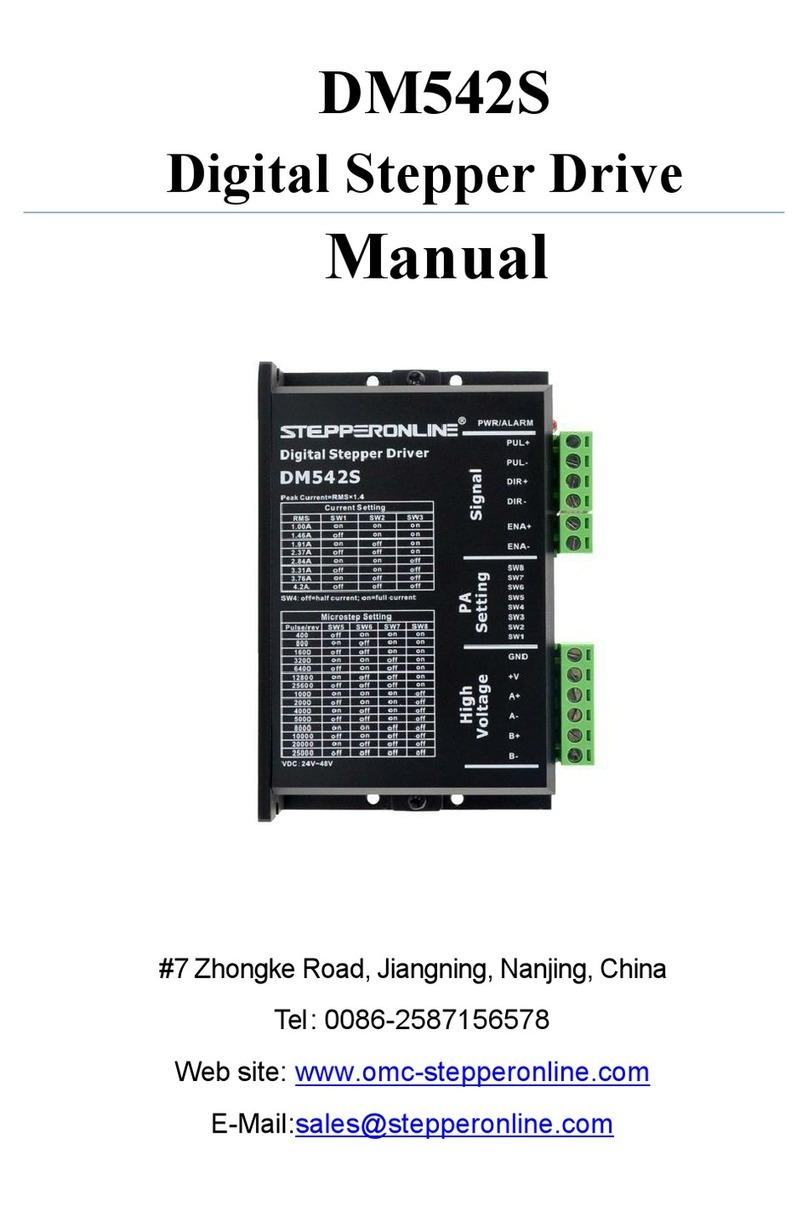
StepperOnline
StepperOnline DM542S User manual
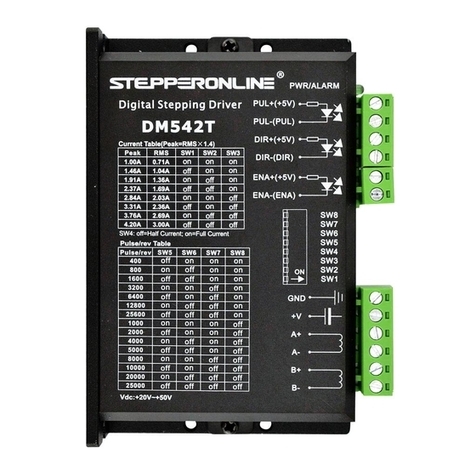
StepperOnline
StepperOnline DM542T User manual

